Chapter 1: Introduction
Chapter 2: Annual catches and overview
Chapter 3: Actual fishing method
Chapter 4: Attention to equipment
Chapter 5: The ecology of Kokanee in my home lake (Lake Numazawa, Fukushima Prefecture)
Chapter 6: Enjoying Kokanee
Chapter 7: Conclusion
Chapter 2: Annual Catches and Overviews
Section 1: Catches by Year
I’ve summarized the catches from 2018 to 2023 in the table below.
While catches became stable from 2019 with the introduction of sonar, they dropped in 2022 when I changed kayaks due to difficulties in mastering the new skills. However, in 2023, I refined my approach to fish and lure methods, and catches improved again.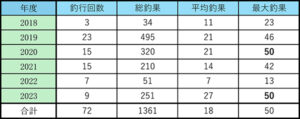
Section 2: Overview of 2018
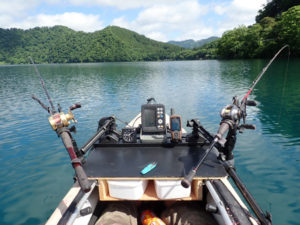 This year marked the serious beginning of my kokanee fishing using a kayak and fish finder. First, I built a custom table to fit the kayak, on which I mounted a fish finder for pond smelt, along with a rod holder and transducer mount. My fishing method involved sabiki fishing with chum, and I tried to stay in as fixed a position as possible. When schools of kokanee arrived, I sometimes hooked fish on both rods, but the waiting time was overwhelmingly long.
This year marked the serious beginning of my kokanee fishing using a kayak and fish finder. First, I built a custom table to fit the kayak, on which I mounted a fish finder for pond smelt, along with a rod holder and transducer mount. My fishing method involved sabiki fishing with chum, and I tried to stay in as fixed a position as possible. When schools of kokanee arrived, I sometimes hooked fish on both rods, but the waiting time was overwhelmingly long.
In the autumn, I introduced an 9-inch Garmin fish finder with a down-scanning transducer, but the fishing method remained essentially the same.
Section 3: Overview of 2019
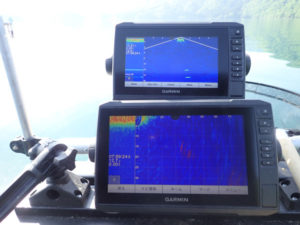 Along with the 9-inch Garmin fish finder, I also introduced a 7-inch fish finder, a forward-scanning sonar, and a down-scanning sonar, solidifying my basic fishing style. Concurrently, this year was also when I gathered fundamental knowledge about kokaee, such as their movement within the lake, and the seasonal layers and shapes of their schools.
Along with the 9-inch Garmin fish finder, I also introduced a 7-inch fish finder, a forward-scanning sonar, and a down-scanning sonar, solidifying my basic fishing style. Concurrently, this year was also when I gathered fundamental knowledge about kokaee, such as their movement within the lake, and the seasonal layers and shapes of their schools.
Although I stopped using chum, catches dramatically increased, averaging 21 fish per outing, with a total nearing 500. This was truly the year I realized the power of sonar.
Section 4: Overview of 2020
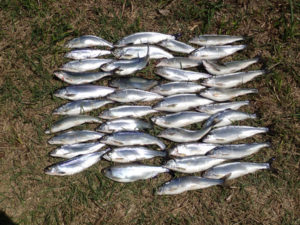 April, the beginning of the season, was excellent, with some days reaching the daily limit of 50 fish for the first time. However, perhaps due to a lower absolute number of fish compared to the previous year, catches did not improve in the latter half of the season.
April, the beginning of the season, was excellent, with some days reaching the daily limit of 50 fish for the first time. However, perhaps due to a lower absolute number of fish compared to the previous year, catches did not improve in the latter half of the season.
The fishing became more challenging from late May to June, when fish gathered in the surface layer, and again after summer. When fish gathered on the surface, they often noticed the kayak even when I approached quietly. After summer, fish returned to the mid-layer, but their reaction to sabiki rigs was very poor, making it difficult to get them to bite.
Section 5: Overview of 2021
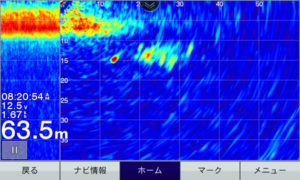 The number of fish decreased even further than the previous year, leading to generally poor catches. The super-large schools (approximately 10m long and 5m thick) that were seen in 2019 completely disappeared.
The number of fish decreased even further than the previous year, leading to generally poor catches. The super-large schools (approximately 10m long and 5m thick) that were seen in 2019 completely disappeared.
Towards the end of the season, I began experimenting with a pedal-drive kayak. With my previous hand-paddled kayak, having transducers on both sides made paddling heavy, like wearing “iron clogs,” and returning to the launch point was particularly exhausting on days with headwinds. By switching to a pedal-drive kayak and mounting the transducer at the stern, it had almost no impact on propulsion, allowing me to travel long distances on the lake.
Section 6: Overview of 2022
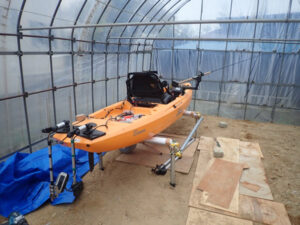 I fully transitioned to a pedal-drive kayak with one fish finder and transducer. I struggled greatly, partly due to the scarcity of fish and partly due to my unfamiliarity with operating the kayak. With the pedal drive, sharp turns and backing up were difficult, making it challenging to accurately drop the rig onto schools.
I fully transitioned to a pedal-drive kayak with one fish finder and transducer. I struggled greatly, partly due to the scarcity of fish and partly due to my unfamiliarity with operating the kayak. With the pedal drive, sharp turns and backing up were difficult, making it challenging to accurately drop the rig onto schools.
Additionally, the commercially available rigs I had been using were discontinued, so I started making my own. I referenced designs published by someone who had achieved stable catches at Lake Saiko in Yamanashi Prefecture, and I specifically included small metal plates, as they seemed to be effective.
Section 7: Overview of 2023
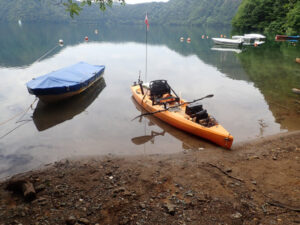 Believing that the poor catches of the previous year were due to my kayak maneuvering skills, I decided to use the pedal drive only for approaching schools, and then switch back to hand-paddling for fine adjustments once near them. Although the schools were still sparse, catches successfully recovered, and I managed to reach the daily limit of 50 fish for the first time in three years.
Believing that the poor catches of the previous year were due to my kayak maneuvering skills, I decided to use the pedal drive only for approaching schools, and then switch back to hand-paddling for fine adjustments once near them. Although the schools were still sparse, catches successfully recovered, and I managed to reach the daily limit of 50 fish for the first time in three years.
I also largely understood the specific timing when kokanee would definitely bite. While dropping the rig directly into a school often startled them into fleeing, dropping it about 5 meters in front or behind the school often resulted in a reactive bite. However, after the summer, they sometimes wouldn’t bite even then, in which case aggressively jigging the rod up and down would occasionally induce a strike.
Chapter 1: Introduction
Chapter 2: Annual catches and overview
Chapter 3: Actual fishing method
Chapter 4: Attention to equipment
Chapter 5: The ecology of Kokanee in my home lake (Lake Numazawa, Fukushima Prefecture)
Chapter 6: Enjoying Kokanee
Chapter 7: Conclusion
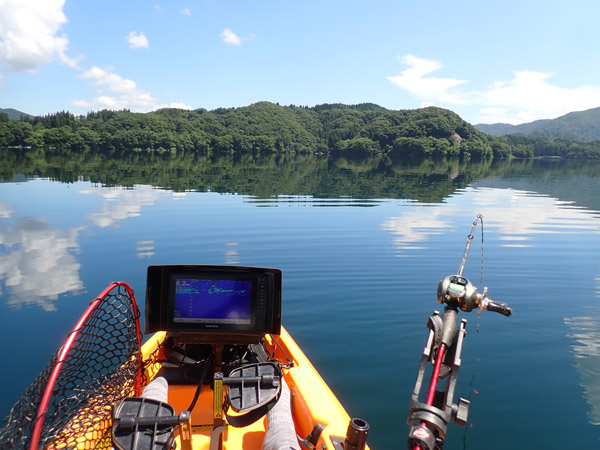
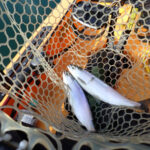

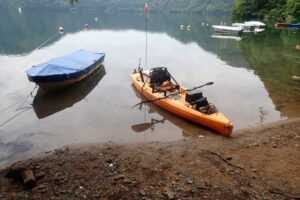
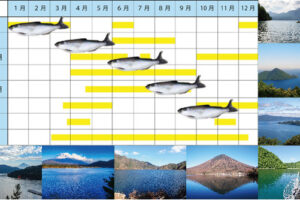
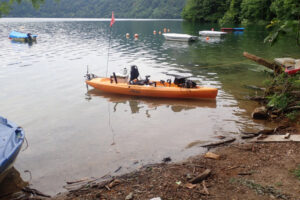
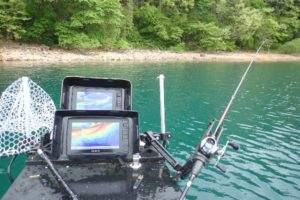
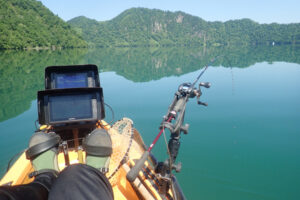
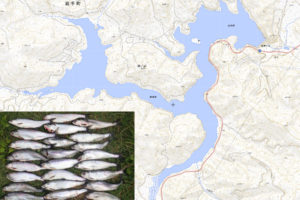
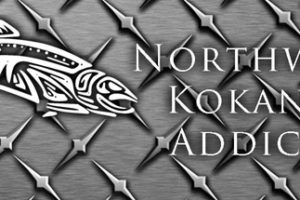
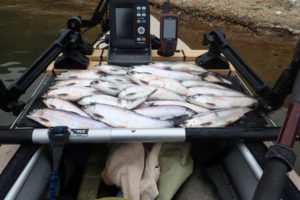
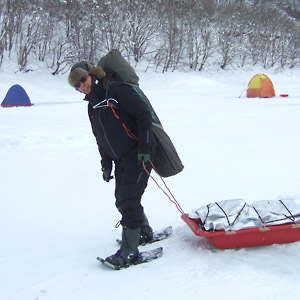
コメントを残す